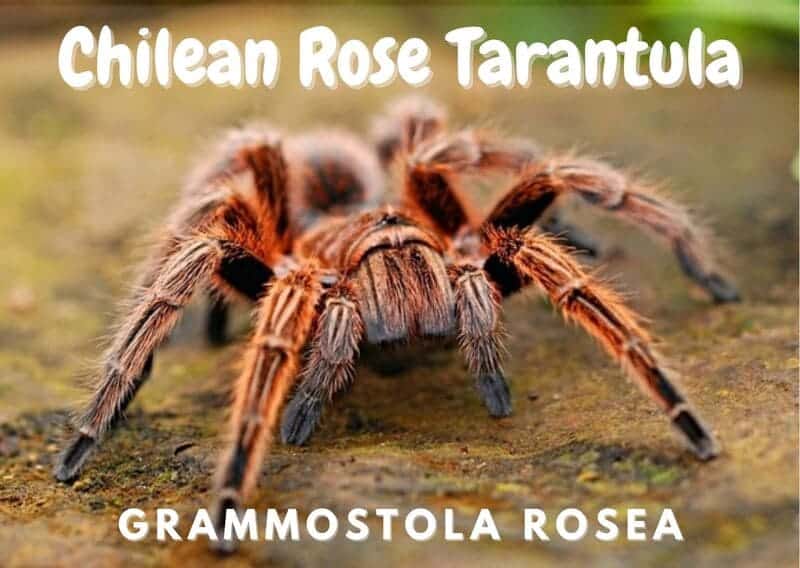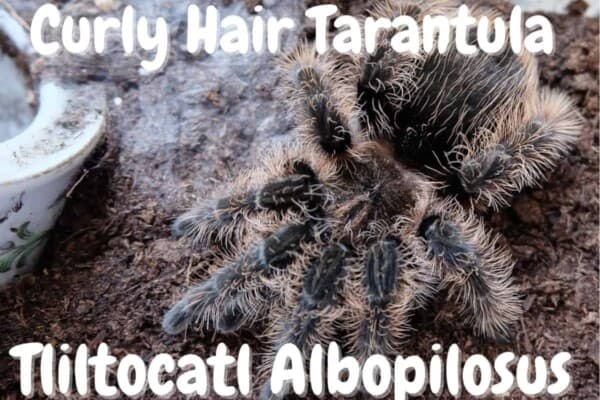The Chilean rose tarantula is an excellent beginner spider that is cute and cuddly for spider lovers. It is well-mannered for a loner terrestrial bird spider species. Despite their living conditions in the dry climates of Northern Chile, they are hard-wired to live in dry conditions.
If you are looking for something different in a tarantula, the Chilean Rose Hair might be for you.
Chilean Rose Tarantula Overview
| Scientific Name | Grammostola Rosea |
| Dwelling | Terrestrial |
| Size | 5-6 inches |
| Lifespan | 5 years (male) / 20 years (female) |
| Food | crickets, grasshoppers, beetles, moths, mealworms, lizards, small pinky mice |
| Difficulty | Beginner |
Grammostola rosea- described by Baron Charles Athanase Waclkenaer (1837) This spider was previously named Phrixotrichus spatulata, that name is now assigned to another species.
Characteristics of the Chilean Rose Tarantula
The physical appearance of the Chilean rose tarantula is split into 3 categories of color. It has been debated among enthusiasts for years, yet these three color variants are all from the Grammostola rosea.
RCF (red color form)
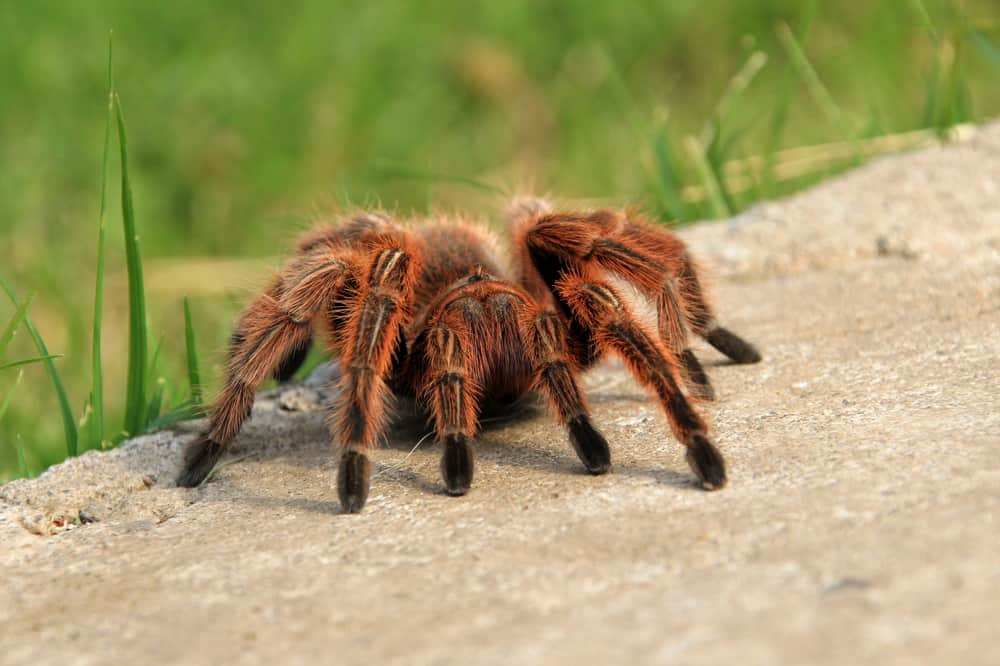
This version will have a copper or red metallic-colored cephalothorax. They also feature deeply colored upper legs with black or dark gray leg tips. Aside from having very bristly or bushy legs, they may have zebra-like stripes on them.
PCF (pink color form)
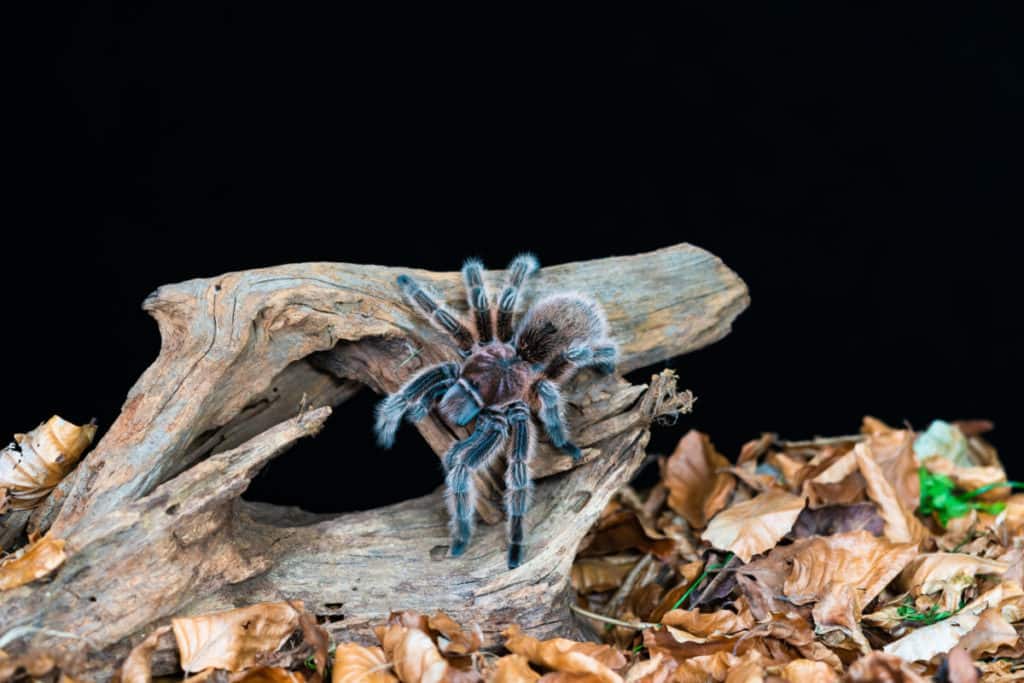
This version of the Chilean Rose will have a natural black color that is covered with long bristly pink hairs. The cephalothorax is also a brilliant metallic pink featuring an ornamental design on the carapace. The zebra-striped legs are also seen clearly.
NCF (normal or natural (gray) color form)
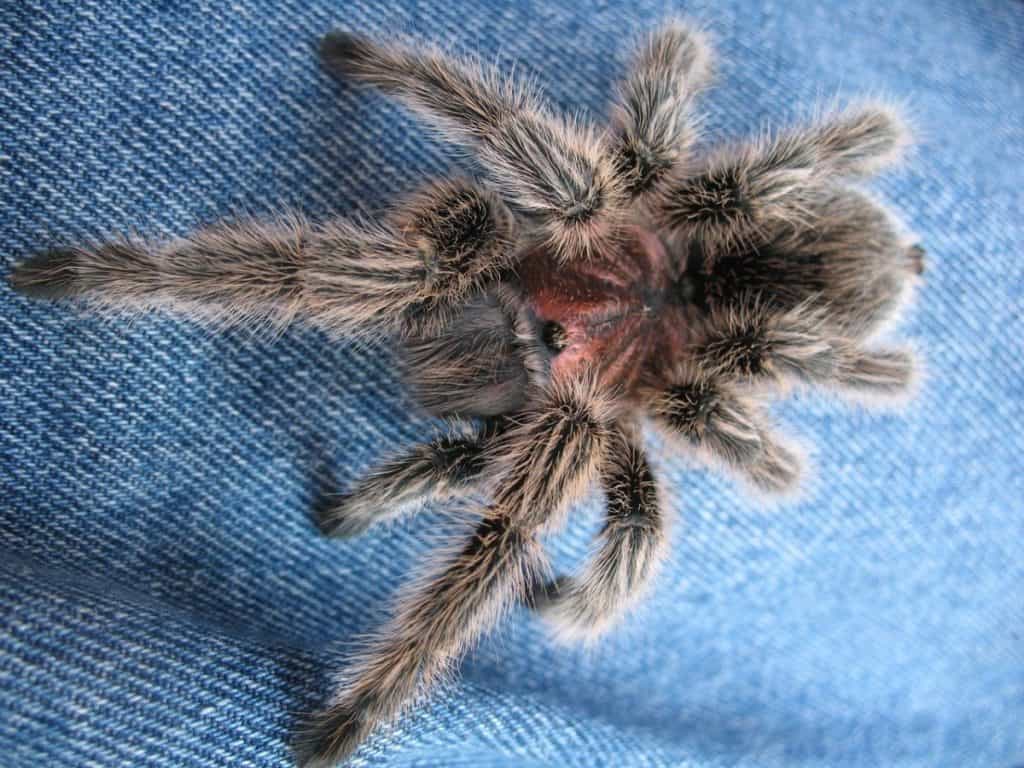
While their dark body color is overshadowed by creamy gray or white hair sticking out everywhere, the cephalothorax is quite notable. It can include ornamental markings draped in shimmering purplish-reds and metallic blues. While the zebra stripes are present, the hair pattern that grows out from the legs stands out much more.
Size
Size can range from 4.5-5.5 inches in length (15-16cm) the leg span will be 5-6 inches (13-15cm). Their body length is typically 6-7cm (just under 3 inches). A male will have a smaller body however their leg length will be the same. They are considered to be medium-sized spiders.
Temperament of the Chilean Rose Tarantula
These spiders are mild-natured and easy-going for the most part. They make a good first-timer pet since they are so docile and calm. They do have their defensive side when they feel threatened. They can raise their front legs and bare their fangs but for the most part, will just retreat. They tend to be skittish too and running from confrontation is common.
Lifespan
A mature female will live upwards of 20-25 years in captivity. In the wild, they may live longer though no data can support this. A male will live a shorter life with a maximum lifespan of 7-8 years if they do not mate.
Difficulty of Care
These teddy-bearish-looking tarantulas make a good beginner tarantula since they are easy to take care of. As long as you are careful around them and provide the climate they need, they will be an entertaining spiders for years. Breeders will have a little bit more to take care of as you will read about later.
Housing the Chilean Rose Hair Tarantula
Type of Housing
The best size housing for the Chilean rose tarantula is 4x their body size within a horizontal tank. A 5-10 gallon tank will be perfectly suitable for them. A smaller spider (about 2 inches) will enjoy a 5-gallon enclosure. Since they have long legs they need space to crawl around their terrain.
It should include a secure lid that cannot be moved by your spider. Side openings are recommended to remove this species and to put in their water and food. Since the females can live up to 20-25 years, we recommend glass housing which will hold up longer over the years.
Cleaning
The task of cleaning your habitat will be pretty easy. Remove the left-over bolus whenever they finish feeding, and regular substrate cleaning should be done once a month. The water should remain clean from substrate material and be refilled every day. They don’t spin much webbing, so decorations inside the habitat will be pretty tidy.
Accessories
Studies in the wild have shown that Rosies can burrow for various reasons you might add a coconut shell hide. They like anything that can be a potential shelter for them.
Decorations that mimic their desert setting can be pieces of bark, cork, or rock-like hiding places. They will need a water dish that is about the size of a V8 twist-off cap or a small mason jar lid.
Humidity
In their native setting, they live in Northern Chile climates. This should be a dry setting, so virtually no humidity is needed. As long as you have 40-55% humidity, this is perfect for this spider. They do not like wet substrate since they spend so much time on the ground.
Have a good hygrometer to monitor the humidity even if there is nothing wet in the habitat. Other than the water dish this should be the only source in the tank.
Temperature
Keep an ideal temperature between 77-80F all year long. You don’t need a heating pad per se but the dry conditions should mimic the desert-like setting. This heat pad should be kept under the tank itself and have heating control. The top of the enclosure should have venting yet still keep most of that heat inside too.
Lighting
Your Rosie will not like direct light, and in the wild, it usually will hide somewhere. There are times when they come out to bask in the sun too. You can add a desk lamp with a 30-watt incandescent bulb to give supplement heat and light. This will simulate the daytime for them. Since they hunt at night be sure to give 12 hours of light and the rest is nighttime for them.
Substrate
They live on dry and hard topsoil most of their lives. Choose a substrate mix that can also allow for burrowing. This should be 50% topsoil and 50% coconut fiber. Using peat or sphagnum moss is not recommended since it’s not desert-like enough.
Cook the soil mixture in a large baking pan at 150F for one hour to dry out the soil and kill any bacteria or mites that could be living inside it. Pack the substrate mixture into your enclosure and spray it generously with water to wet out the surface layers. It should be 4-5 inches thick. Let it dry out for a few days and monitor the humidity levels. When it reaches 40-55% it will be ready to put in your spider.
Feeding your Chilean Rose Hair Tarantula
The diet of the Chilean rose includes crickets, grasshoppers, beetles, moths, mealworms or grubs, lizards, and small vermin. You can substitute a pinky mouse that is the size of your spider’s carapace. Smaller spiders can eat little crickets, wax worms, and wingless fruit flies.
How often do you feed a Grammostola Rosea?
This spider hunts at night so don’t expect a show in the daytime. They will eat as much as they feel is necessary and if they stop eating, that should be it. Do not overfeed this species, they live in desert conditions and eat only what they can. You might find that they will not eat for a month.
If they refuse their food, remove it and wait another week before trying again. They will repeat this behavior when they are going to molt too, so don’t panic.
Drink
What spider doesn’t like a glass of water now and then? This species will need water in their enclosure and will appreciate the gesture. Without water, they will become dehydrated or even die. Be sure to put fresh water in the habitat just under the soil line. A mayonnaise lid or Snapple cap works great.
Handling the Chilean Rose Tarantula
This species is docile enough to be handled with your hands and rarely bites. Even at that, if this spider does bite their venom is not deadly. A bite can hurt as much as a bee sting and those prone to allergic reactions should be wary. It will flick urticating hairs on you if it gets scared too. These can be itchy and should be washed off quickly.
Common Chilean Rose Tarantula health problems
This is a very independent and hardy spider so related health problems don’t happen unless you are doing something wrong. It will refuse food if they aren’t hungry, so don’t force weekly feedings.
Don’t feed them after their molt since they need to harden up properly. Juveniles need less time to dry out than adults do. A fully grown adult can take weeks to make their exoskeleton hard enough to feed. Feeding them before that can even damage their fangs. Never give them live food that is bigger than their carapace size.
If they are hanging on the side of the glass, it can mean there is a problem with the soil. There could be parasites or mites and that is bad for your spider. Even if they lose a leg by accident, they will regenerate a new leg over time.
Chilean Rose Tarantula Breeding Guide
Breeding will happen after they molt in their 2nd or 3rd year. They are then ready to reproduce. Once they finish molting, you need to allow them 4-6 weeks before they can be put together for mating.
The male has a tibial hook that has a syringe-like chamber that stores his sperm. Unlike other spiders, he will not make a sperm sack.
Once the two tarantulas are put together, the male will approach the female and do his tapping to entice the female. If she is receptive he can then pose her to deposit his sperm. If he is lucky (as most aren’t) he can make a quick getaway. Soon after mating the male will usually die. His job in life is thus completed.
How many eggs?
It takes 6 weeks for the female to lay her eggs after mating. There can be up to 500 eggs in one cocoon. They will hatch 70-90 days after being in the cocoon that she carries around with her constantly. If you can be careful enough and catch her off-guard, you can retrieve the egg sack.
What to do with spiderlings
Eggs need to be incubated if you decide to hatch them away from the mother. You need to wait until they are at least 3 months old before selling them to potential buyers. These little spiders need to be stored individually and with up to 500 spiders is hard work. Try finding sources online that buy them in bulk.
You can go the long road home and sell them piece by piece for a better turn-out profit. Since the Chilean rose is sought after there should be no limit to interested buyers.
Availability of the Chilean Rose Hair Tarantula
If you have never owned this species before, be sure to do some research before you buy one. Price is a consideration since this spider is usually on the pricy side.
Spider expos or reptile shows are a great source to find cheaper spiderlings that you can raise. They are not as rare as you have been led to think.
Resources and further reading:
- Collection and characterization of semen from Chilean rose tarantulas (Grammostola rosea), Kate E. Archibald, Larry J. Minter, Gregory A. Lewbart
Contents
- Chilean Rose Tarantula Overview
- Characteristics of the Chilean Rose Tarantula
- Housing the Chilean Rose Hair Tarantula
- Feeding your Chilean Rose Hair Tarantula
- Handling the Chilean Rose Tarantula
- Common Chilean Rose Tarantula health problems
- Chilean Rose Tarantula Breeding Guide
- Availability of the Chilean Rose Hair Tarantula

